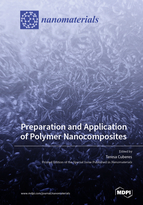Preparation and Application of Polymer Nanocomposites
A special issue of Nanomaterials (ISSN 2079-4991). This special issue belongs to the section "Nanocomposite Materials".
Deadline for manuscript submissions: closed (31 December 2021) | Viewed by 22901
Special Issue Editor
Interests: polymer nanocomposites; scanning probe microscopy
Special Issues, Collections and Topics in MDPI journals
Special Issue Information
Dear Colleagues,
With the advent of nanotechnology, the incorporation of nanofillers to a polymer matrix has prompted a breakthrough in materials development, providing polymer nanocomposites with improved mechanical, thermal, electrical, dielectric, optoelectronic and magnetic properties. Typically, the nanofillers affect the properties of the host matrix, and contribute to the composite performance with properties of their own. The structure and behavior of the interface between the nanofiller and the matrix play a most relevant role. Effort is being devoted to study the mobility of nanofillers inside a matrix, their aggregation, or their possible release to the environment.
Polymer nanocomposites have found applications as membranes in batteries and fuel cells, in biomedicine, for drug delivery, or as scaffolds for tissue regeneration, and in electrical/optoelectronic devices such as solar cells. Smart, responsive materials have been developed and used as sensors, actuators, and low-voltage energy generators for wearables.
This Special Issue is focused on the characterization of polymer nanocomposite films with special emphasis on their structure and interface properties, and their mechanical and electrical response. Research addressing the impact on the nanofiller/matrix interface of external conditions such as heat, electrical/magnetic, mechanical, or ultrasonic action is of particular interest. Contributions related to biocompatible, ecofriendly, and biodegradable polymer nanocomposites are welcome.
Prof. Teresa Cuberes
Guest Editor
Manuscript Submission Information
Manuscripts should be submitted online at www.mdpi.com by registering and logging in to this website. Once you are registered, click here to go to the submission form. Manuscripts can be submitted until the deadline. All submissions that pass pre-check are peer-reviewed. Accepted papers will be published continuously in the journal (as soon as accepted) and will be listed together on the special issue website. Research articles, review articles as well as short communications are invited. For planned papers, a title and short abstract (about 100 words) can be sent to the Editorial Office for announcement on this website.
Submitted manuscripts should not have been published previously, nor be under consideration for publication elsewhere (except conference proceedings papers). All manuscripts are thoroughly refereed through a single-blind peer-review process. A guide for authors and other relevant information for submission of manuscripts is available on the Instructions for Authors page. Nanomaterials is an international peer-reviewed open access semimonthly journal published by MDPI.
Please visit the Instructions for Authors page before submitting a manuscript. The Article Processing Charge (APC) for publication in this open access journal is 2900 CHF (Swiss Francs). Submitted papers should be well formatted and use good English. Authors may use MDPI's English editing service prior to publication or during author revisions.
Keywords
- Polymer nanocomposites
- Polymer films
- Polymer membranes
- Nanofillers
- Nanoparticles
- Carbon allotropes.
- 2D materials
- Nanocellulose
- Polymer/nanofiller interface







